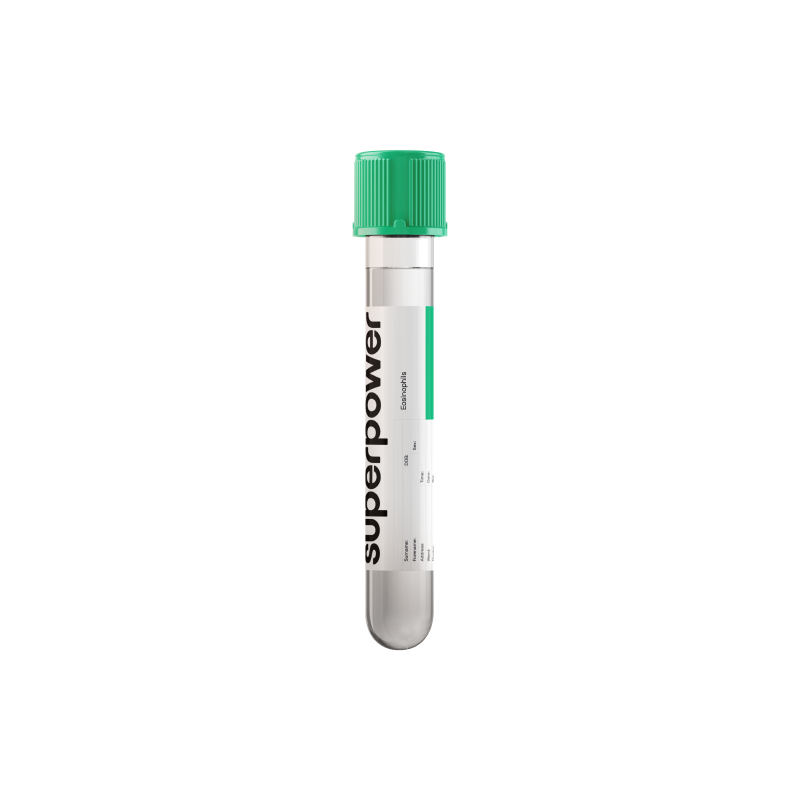Reported as both an absolute count and percentage of white blood cells, eosinophils help distinguish allergic from infectious causes of symptoms like cough, wheeze, rash, or gut pain. Testing sharpens asthma and allergy care, monitors therapy response, and flags rare but important eosinophil-related conditions.
Key Benefits
- Spot allergic and parasite-driven immune activity in your blood.
- Flag allergic inflammation driving asthma, eczema, or chronic sinus symptoms.
- Guide inhaled steroid or biologic medicine choices when eosinophils run high.
- Raise suspicion for parasitic worms when travel or digestive symptoms align.
- Spot drug hypersensitivity or conditions with very high eosinophils needing urgent evaluation.
- Prompt checks for heart, lung, or gut injury with very high counts.
- Track trends as counts fall with treatment or rise with uncontrolled disease.
- Best interpreted with CBC differential, symptoms, travel, allergies, and medication history.
What is Eosinophils?
Eosinophils are a specialized subtype of white blood cell that arise in the bone marrow. After maturing, they circulate briefly in the blood and then settle mainly in barrier tissues such as the gut, lungs, and skin. Under the microscope they stain bright pink with the dye eosin because their cytoplasm is packed with enzyme-filled granules. These granules store potent proteins that can damage invaders, including major basic protein and eosinophil peroxidase (granulocytic leukocytes; cytotoxic granules). Their production and survival are strongly driven by the signaling molecule interleukin‑5 and by eotaxins (IL‑5; CCL11).
Eosinophils are built to combat multicellular parasites and to orchestrate type 2 immune responses. When activated, they release granule proteins, cytokines, and lipid mediators that help immobilize and kill worms, but the same arsenal also amplifies allergy and asthma symptoms (helminth defense; Th2 inflammation). They communicate with mast cells and antibodies, especially IgE, and contribute to tissue remodeling and barrier defense. A blood eosinophil count gives a snapshot of how many of these cells are being produced and mobilized, serving as a readout of eosinophil‑driven inflammation.
Why is Eosinophils important?
Eosinophils are a specialized white blood cell that patrols your airways, gut, and skin. They help defend against parasites and shape allergic inflammation by releasing potent granule proteins and signaling molecules. In balance, they support barrier immunity; in excess, they can injure tissues and remodel organs.
In most healthy people, eosinophils make up only a small, single‑digit slice of all white cells. When you’re well, values tend to sit toward the low end of the normal range because there’s little allergen or parasite stimulus.
When eosinophils are low, it usually reflects strong “stress” signals—your own cortisol, acute infection, trauma, or exposure to glucocorticoid medicines—which push eosinophils out of circulation or suppress their production. This state is often silent, though allergies may seem less reactive. Pregnancy, especially later stages, commonly shifts counts lower for the same hormone reasons. In children, transient lows are typically benign and relate to recent illness.
When eosinophils are high, the immune system is often running a type‑2 (allergic/anti‑parasite) program. Asthma, eczema, chronic sinusitis, food allergy, and parasitic infections are common drivers. Symptoms may include wheeze, cough, itchy rashes, abdominal pain, or diarrhea. Marked or persistent elevations can inflame organs—lungs, gut, skin, and, rarely, heart and nerves—leading to fatigue, breathlessness, or chest symptoms. In kids, elevations frequently track with atopy or parasites; in pregnancy, sustained high counts with symptoms can signal pathology.
Big picture: eosinophils sit at the crossroads of barrier immunity, IgE/mast‑cell activity, and hormonal stress responses. Their pattern over time connects to airway health, skin and gut integrity, and even cardiovascular risk when markedly elevated, linking everyday exposures to long‑term organ outcomes.
What Insights Will I Get?
Eosinophils are white blood cells that drive type 2 immunity at airways, skin, and gut. They respond to parasites and allergens, releasing granule proteins and cytokines that shape inflammation and repair. Their level reflects allergic tone, parasite exposure, and cortisol signaling, with effects on breathing, skin, gut, and, rarely, heart and nerves.
Low values usually reflect heightened cortisol signaling from illness, surgery, or glucocorticoid medicines, which reduce circulating cells (eosinopenia). They also occur in acute bacterial infection or Cushing syndrome. Alone, low counts rarely cause symptoms and mainly mark a stress response. Pregnancy and morning sampling lower values; children’s ranges run higher.
Being in range suggests balanced barrier immunity without active allergic or parasitic signals, and appropriate adrenal tone. It implies stable airway, skin, and gut homeostasis without excess tissue-damaging granule release. In healthy adults without atopy, values often sit in the lower-to‑mid range.
High values usually reflect type 2 immune activation from allergies/asthma, parasitic infection, drug reactions, or eosinophilic skin and gut disease. They also occur with low cortisol (adrenal insufficiency), autoimmune conditions, and, less commonly, clonal blood disorders and hypereosinophilic syndromes. Effects range from airway and skin inflammation to abdominal pain; very high, persistent counts risk organ damage (heart, nerves).
Notes: Counts vary by time of day, season, allergen exposure, infections, and medicines; glucocorticoids lower them, while steroid withdrawal or ACTH deficiency can raise them. Interpret with the absolute count and clinical context; pregnancy and childhood require age‑ and state‑specific ranges.



.svg)



.png)
.png)
.png)
.png)








